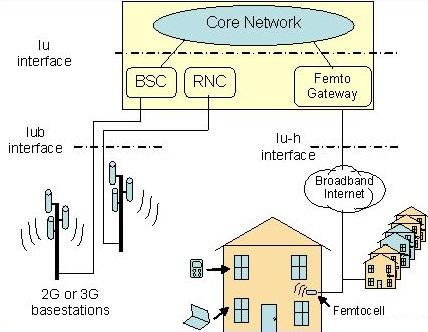The femtocell appears to the standard 3G phone as just another cellsite from the host mobile operator. MSC and SGSN communicate to the femtocell gateway in the same way as for other mobile calls. Therefore, all services including phone numbers, call diversion, voicemail etc. operate in exactly the same way as previous.
The connection between the femtocell and the femtocell gateway uses secure IP encryption (IPsec), which avoids interception and there is also authentication of the femtocell itself to ensure it is a valid access point.

Inside the femtocell are the complete workings of a mobile phone basestation. Additional functions are also included such as some of the RNC (Radio Network Controller) processing, which would normally reside at the mobile switching centre. Some femtocells also include core network element so that data sessions can be managed locally without needing to flow back through the operators switching centres.
The extra capabilities of a femtocell demand it to be self-installing and self-configuring. This requires considerable extra software which scans the environment to determine the available frequencies, power level and/or scrambling codes to be used. This is a continuous process to adapt to changing radio conditions, for example if the french windows are opened in a room containing the femtocell.
Within the operators network, femtocell gateways aggregate large numbers of femtocell connections (typically 100,000 to 300,000) which are first securely connected through high capacity IP security firewalls.
Enterprise Small Cells
The same technology and architecture is also used for small to medium businesses. Typically the small cells have higher capacity and slightly higher RF power to give a larger range. Some enterprise small cell vendors have developed solutions where small cells co-operate in clusters to provide seamless service. For larger enterprises, a small cell controller may be used to provide additional local services including direct connection to the enterprise network.
Metrocells and Rural Small Cells
Public areas, both inside and out, may use specially designed metrocells which are also based on the same architecture. These can also take advantage of the same small cell/femtocell gateway, sharing its use between residential, enterprise and metrocell installations. These products must be weather proof and vandal proof, operating in sometimes harsh unsupervised environments with wide temperature fluctuations. Metrocells are installed by the network operator themselves, and a broadband IP connection (called the backhaul) is also required.
